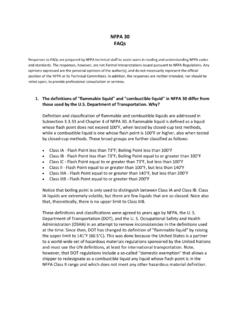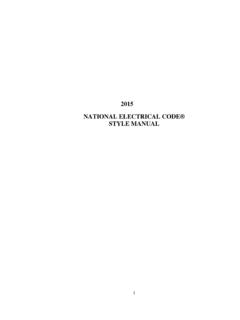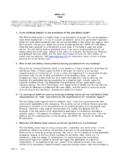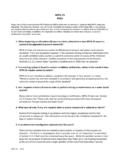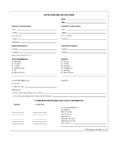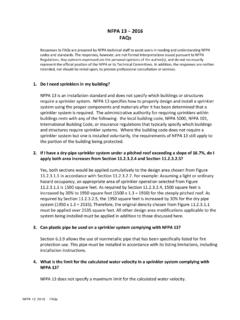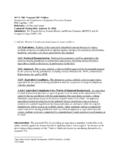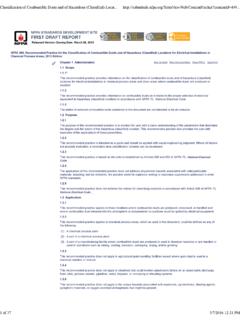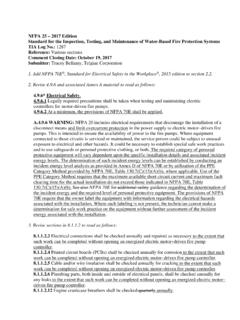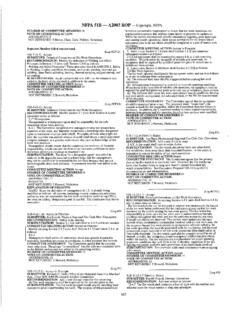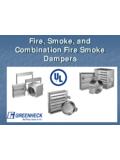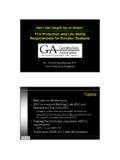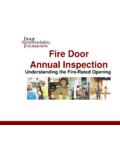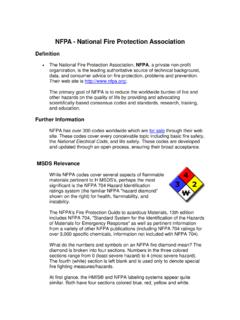Transcription of NFPA 72 FAQs
1 nfpa 72 faqs Responses to faqs are prepared by nfpa technical staff to assist users in reading and understanding nfpa codes and standards. The responses, however, are not Formal Interpretations issued pursuant to nfpa Regulations. Any opinions expressed are the personal opinions of the author(s), and do not necessarily represent the official position of the nfpa or its Technical Committees. In addition, the responses are neither intended, nor should be relied upon, to provide professional consultation or services.
2 1. Does nfpa 72 , National Fire Alarm and Signaling Code require fire alarm systems to be installed? No. nfpa 72 only provides requirements for the installation, performance, testing, inspection, and maintenance of the fire alarm system. nfpa 101 , Life Safety Code and other codes determine whether a fire alarm system is required in a given occupancy. 2. What document covers the wiring of a fire alarm system? nfpa 70 , National Electrical Code , NEC covers wiring of a fire alarm system, but does not cover performance of a fire alarm system.
3 nfpa 72, National Fire Alarm and Signaling Code covers the requirements for installation performance of fire alarm systems. 3. Does nfpa 72 require occupant notification by means of notification appliances? No. nfpa 101, Life Safety Code and other codes determine whether occupant notification is required in a given occupancy. However, Chapter 18 of nfpa 72 does require visible signaling if the ambient sound pressure level is above 105 dBA. 4. Does nfpa 72 require automatic fire detection devices? No. nfpa 101, Life Safety Code and other codes determine whether fire alarm initiating devices are required in a given occupancy.
4 However, Section requires fire alarm control units, NAC power extenders and supervising station transmitting equipment not located in continuously occupied areas to be protected by smoke detection even if no automatic detection devices are otherwise required. 5. Is a sprinkler supervisory fire alarm system considered to be a fire alarm system? Yes. The definition of a fire alarm system in includes these systems. 6. Can non traditional telephone service be used with a digital alarm communicator system? Yes, if the service is provided through a managed facilities based voice network (MFVN).
5 nfpa 72 addresses several means of transmitting alarm and other signals from a fire alarm system at a protected premise to a supervising station. The most widely used means is a digital alarm communicator system. These systems use a digital alarm communicator transmitter (DACT) connected through two transmission channels. The Code requires the primary channel to be a telephone line. The secondary channel can be a second telephone line, or one of 6 other transmission means. With respect to the telephone line(s), the Code requires in that the DACT be connected to the public switched telephone network upstream of any private telephone system at the protected premise.
6 It also requires that the connection be to a loop start telephone circuit. Historically, this meant connection to the copper conductors of a plain old telephone system (POTS) traditionally provided by the telephone company. In recent years, providers of telephone service other than the traditional POTS service have become more common. The 2010 edition of the Code includes revisions to address the use of these non traditional types of telephone service. The 2010 edition of nfpa 72 includes the following revised the definition of a public switched telephone network and a new definition of managed facilities based voice networks: Public Switched Telephone Network (PSTN).
7 An assembly of communications equipment and telephone service providers that utilize managed facilities based voice networks (MFVN) to provide the general public with the ability to establish communications channels via discrete dialing codes. Managed Facilities Based Voice Network (MFVN). A physical facilities based network capable of transmitting real time signals with formats unchanged that is managed, operated, and maintained by the service provider to ensure service quality and reliability from the subscriber location to public switched telephone network (PSTN) interconnection points or other MFVN peer networks.
8 The Code contains extensive explanatory annex information related to what is expected of a MFVN. It is important to recognize that telephone service that that is not provided through a physical facilities based network would not be covered under this definition. It is also important to understand that the telephone service provider s communications equipment is expected to provide 8 hours of standby power for equipment installed on the premises or located in the field. This is in contrast to the 24 hours of secondary power required for the fire alarm system itself, including the DACT.
9 Those using or enforcing earlier editions of the Code will find the revisions in the 2010 edition of nfpa 72 useful in understanding the capabilities and performance expected for the communication pathways used in conjunction with digital alarm communicator systems.
